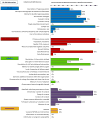Translational research: bridging the gap between long-term weight loss maintenance research and practice
- PMID: 20869490
- PMCID: PMC2967429
- DOI: 10.1016/j.jada.2010.07.005
Translational research: bridging the gap between long-term weight loss maintenance research and practice
Abstract
The number of US adults classified as overweight or obese has dramatically increased in the past 25 years, resulting in a significant body of research addressing weight loss and weight loss maintenance. However, little is known about the potential of weight loss maintenance interventions to be translated into actual practice settings. Thus, the purpose of this article is to determine the translation potential of published weight loss maintenance intervention studies by determining the extent to which they report information across the reach, efficacy/effectiveness, adoption, implementation, and maintenance (RE-AIM) framework. A secondary purpose is to provide recommendations for research based on these findings. To identify relevant research articles, a literature search was conducted using four databases; 19 weight loss maintenance intervention studies were identified for inclusion. Each article was evaluated using the RE-AIM Coding Sheet for Publications to determine the extent to which dimensions related to internal and external validity were reported. Approximately half of the articles provided information addressing three RE-AIM dimensions, yet only a quarter provided information addressing adoption and maintenance. Significant gaps were identified in understanding external validity, and metrics that could facilitate the translation of these interventions from research to practice are presented. Based upon this review, it is unknown how effective weight loss maintenance interventions could be in real-world situations, such as clinical or community practice settings. Future studies should be planned to address how weight loss maintenance intervention programs will be adopted and maintained, with special attention to costs for participants and for program implementation.
Copyright © 2010 American Dietetic Association. Published by Elsevier Inc. All rights reserved.
Figures
References
-
- Mokdad AH, Ford ES, Bowman BA, Dietz WH, Vinicor F, Bales VS, Marks JS. Prevalence of obesity, diabetes, and obesity-related health risk factors, 2001. JAMA. 2003;289(1):76–79. - PubMed
-
- Odgen CL, Carroll MD, McDowell MA, Flegal KM. NCHS data brief no. 1. Hyattsville, MD: National Center for Health Statistics; 2007. Obesity among adults in the United States—no statistically significant change since 2003–2004. - PubMed
-
- Ogden CL, Carroll MD, Curtin LR, McDowell MA, Tabak CJ, Flegal KM. Prevalence of overweight and obesity in the United States, 1999–2004. JAMA. 2006;295(13):1549–1555. - PubMed
-
- Klein S, Burke LE, Bray GA, Blair SE, David B, Pi-Sunyer X, Hong Y, Eckel RH. Clinical implications of obesity with specific focus on cardiovascular disease: A statement for professionals from the American Heart Association Council on Nutrition, Physical Activity, and Metabolism: Endorsed by the American College of Cardiology Foundation. Circulation. 2004;110(18):2952–2967. - PubMed
-
- Poirier PG, Thomas D, Bray GA, Hong Y, Stern JS, Pi-Sunyer XF, Eckel RH. Obesity and cardiovascular disease: Pathophysiology, evaluation, and effect of weight loss: An update of the 1997 American Heart Association Scientific Statement on Obesity and Heart Disease From the Obesity Committee of the Council on Nutrition, Physical Activity, and Metabolism. Circulation. 2006;113(6):898–918. - PubMed
Publication types
MeSH terms
Grants and funding
LinkOut - more resources
Full Text Sources
Medical
Miscellaneous


